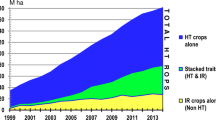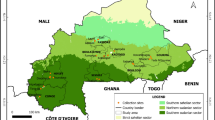Abstract
Understanding how genetic variation is organized over geography has long been of interest to evolutionary biologists given that traits can vary within and among populations, across regions, and at continental or global scales. The pattern of regional variation can have an important impact on trait evolution at the local or population level. Using a common garden, we asked whether a geographically variable mosaic of tolerance to the widely applied herbicide RoundUp® existed in two closely related co-occurring species of morning glory, Ipomoea purpurea and I. hederacea. We assayed RoundUp tolerance in over 1,700 plants representing 290 families from 29 populations in the southeastern United States. Our findings suggest that the two species of morning glory partition their respective levels of genetic variation for tolerance to glyphosate differently. Variation for tolerance in I. purpurea appears to exist among maternal lines and regions, whereas in I. hederacea, variation in tolerance existed only among populations. In addition, we find a significant hotspot of tolerance or positive spatial aggregation of this trait on a local scale in I. purpurea populations from the Coastal Plain. This suggests that either similar regimes of selection or gene flow between populations can produce a geographic mosaic of tolerance. These results highlight the fact that the genetic variation underlying an adaptive trait can exist at many different scales, whether it be within- or among-populations, among geographical ‘hotspots,’ or among distinct ecological regions. Given these results, the partitioning of genetic variation should be considered before making predictions about an adaptive trait’s evolutionary trajectory.




Similar content being viewed by others
References
Abrahamson WG, Weis AE (1997) Evolutionary ecology across three trophic levels: goldenrods, gall-makers, and natural enemies. Princeton University Press, Princeton
Amrhein N, Deus B, Gehrke P, Steinrucken HC (1980) The site of the inhibition of the shikimate pathway by glyphosate. Plant Phys 66:830–834
Baucom RS, Mauricio R (2004) Fitness costs and benefits of novel herbicide tolerance in a noxious weed. Proc Natl Acad Sci USA 101:13386–13390
Brodie ED Jr, Ridenhour BJ, Brodie ED III (2002) The evolutionary response of predators to dangerous prey: hotspots and coldspots in the geographic mosaic of coevolution between garter snakes and newts. Evolution 56:2067–2082
Brown BA, Clegg MT (1984) Influence of flower color polymorphism on genetic transmission in a natural population of the common morning glory, Ipomoea purpurea. Evolution 38:796–803
Burdon JJ, Thrall PH (1999) Spatial and temporal patterns in coevolving plant and pathogen associations. Am Nat 153:S15–S33
Caseley JC, Coupland D (1985) Environment and plant factors affecting glyphosate uptake, movement and activity. In: Grossbard E, Atkinson D (eds) The herbicide glyphosate. Butterworths, London, pp 92–124
Chang SM, Rausher MD (1998) Frequency-dependent pollen discounting contributes to maintenance of a mixed mating system in the common morning glory Ipomoea purpurea. Am Nat 152:671–683
Dill GM (2005) Glyphosate-resistant crops: history, status and future. Pest Manag Sci 61:219–224
Endler JA (1977) Geographic variation, speciation, and clines. Princeton University Press, Princeton
Ennos RA (1981) Quantitative studies of the mating system in two sympatric species of Ipomoea (Convolvulaceae). Genetica 57:93–98
Epperson BK, Li T (1996) Measurement of genetic structure within populations using Moran’s spatial autocorrelation statistics. Proc Natl Acad Sci USA 93:10528–10532
Fineblum WL, Rausher MD (1995) Tradeoff between resistance and tolerance to herbivore damage in a morning glory. Nature 377:517–520
Franz JE, Mao MK, Sikorski JA (1997) Uptake, transport and metabolism of glyphosate in plants. In: Franz JE (ed) Glyphosate: a unique global herbicide. American Chemical Society, Washington, DC, pp 143–181
Grossbard E, Atkinson D (1985) The herbicide glyphosate. Butterworths, London
Guries RP (1978) Test of the mentor pollen technique in the genus Ipomoea. Euphytica 27:825–830
Hamrick JL, Godt MJM (1989) Allozyme diversity in plant species. In: Brown AHD, Clegg MT, Kahler AL, Weir BS (eds) Plant population genetics, breeding and genetic resources. Sinauer, Sunderland, MA, pp 43–63
Hamrick JL, Godt MJW (1996) Effects of life history traits on genetic diversity in plant species. Philos Trans R Soc Lond B 351:1291–1298
Hutchinson GE (1959) Homage to Santa-Rosalia or why are there so many kinds of animals. Am Nat 93:145–159
Mauricio R, Rausher MD, Burdick DS (1997) Variation in the defense strategies of plants: are resistance and tolerance mutually exclusive?. Ecology 78:1301–1311
Miller RE, Buckley TR, Manos PS (2002) An examination of the monophyly of morning glory taxa using Bayesian phylogenetic inference. Syst Bio 51:740–753
Miller RE, McDonald JA, Manos PS (2004) Systematics of Ipomoea subgenus quamoclit (Convolvulaceae) based on its sequence data and a Bayesian phylogenetic analysis. Am J Bot 91:1208–1218
Moran PAP (1950) Notes on continuous stochastic phenomena. Biometrika 37:17–23
Rausher MD (1992a) The measurement of selection on quantitative traits: biases due to the environmental covariances between traits and fitness. Evolution 46:616–626
Rausher MD (1992b) Natural selection and the evolution of plant-insect interactions. In: Roitberg BD, Isman MS (eds) Insect chemical ecology: an evolutionary approach. Routledge, Chapman and Hall, New York, USA, pp 20–88
SAS Institute (1990) Sas/Stat user’s guide. SAS Institute Inc., Cary, NC
Sawada M (1999) ROOKCASE: An Excel 97/2000 Visual Basic (VB) add-in for exploring global and local spatial autocorrelation. Bull Ecol Soc Am 80:231–234
Simms EL, Triplett J (1994) Costs and benefits of plant response to disease: resistance and tolerance. Evolution 48:1973–1985
Spitze K (1993) Population structure in Daphnia obtusa: quantitative genetic and allozymic variation. Genetics 135:367–374
Steinrucken HC, Amrhein N (1980) The herbicide glyphosate is a potent inhibitor of 5-enolpyruvylshikimic acid-3-phosphate synthase. Biochem Biophys Res Comm 94:1207–1212
Stinchcombe JR, Rausher MD (2002) The evolution of tolerance to deer herbivory: modifications caused by the abundance of insect herbivores. Proc R Soc Lond B 269:1241–1246
Thompson JN (1997) Evaluating the dynamics of coevolution among geographically structured populations. Ecology 78:1619–1623
Tiffin P, Inouye BD (2000) Measuring tolerance to herbivory: accuracy and precision of estimates made using natural versus imposed damage. Evolution 54:1024–1029
Tiffin P, Rausher MD (1999) Genetic constraints and selection acting on tolerance to herbivory in the common morning glory Ipomoea purpurea. Am Nat 154:700–716
Warwick SI (1991) Herbicide resistance in weedy plants: physiology and population biology. Ann Rev Ecol Syst 22:95–114
Webster TM (2004) Weed survey—Southern states: grass crops subsection. Proc South Weed Sci Soc 57:404–426
Weinig C, Stinchcombe JR, Schmitt J (2003) Evolutionary genetics of resistance and tolerance to natural herbivory in Arabidopsis thaliana. Evolution 57:1270–1280
Wright S (1943) Isolation by distance. Genetics 28:114–138
Acknowledgments
The authors wish to thank V. Corby, L. Donovan, J. Estill, V. Koelling, and J. Ross-Ibarra for careful readings of the manuscript, J. Hamrick and J. Stinchcombe for helpful comments about the analysis, and J. Estill for assistance with data analysis and map making. The authors would also like to thank K. Donohue and two anonymous reviewers for thoughtful suggestions that improved the manuscript. Many thanks to the following for planting help: M. Brown, D. Gotzek, T. Haselkorn, V. Koelling, C. Richards, J. Ross-Ibarra, and J. Sterling. This project would not have been possible without the unwavering attention of M. Boyd and A. Tull in the Plant Biology Greenhouses. Funding was provided to RSB from the Mechanisms of Plant Evolution Training Grant (DBI 9602223), and an NSF DDIG (DEB-0308869).
Author information
Authors and Affiliations
Corresponding author
Rights and permissions
About this article
Cite this article
Baucom, R.S., Mauricio, R. The evolution of novel herbicide tolerance in a noxious weed: the geographic mosaic of selection. Evol Ecol 22, 85–101 (2008). https://doi.org/10.1007/s10682-007-9160-1
Received:
Accepted:
Published:
Issue Date:
DOI: https://doi.org/10.1007/s10682-007-9160-1




